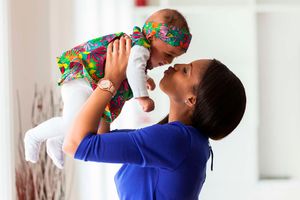Fever 101: What to do and when to call a doctor

What you need to know:
- It is more important to watch how your child is behaving. If the baby is eating and sleeping well, and has occasional periods of playfulness, they probably do not need any treatment.
Fever is a common feature in babies. It is the first sign from a baby that something is wrong.
Infants are considered to have fever if their temperature is 38 degrees celsius or higher (when measured via the rectal method) or 37.2 degrees celsius using other methods.
Although fever is itself not dangerous, the underlying causes for it can be. Babies can get a fever due to vaccinations, viral infections, bacterial infections, etc.
Other conditions that are associated with illnesses that lead to fever include pneumonia, meningitis, croup, ear infections, influenza, colds, blood and bowel infections.
In most cases, infants are more likely to have fever when the cause requires pediatric treatment unlike older babies.
According to the John Hopkins Children’s Center, about 90 per cent of parents will give their children fever-reducing medicines before their children’s temperature reaches 38.4 degrees Celsius.
Most parents are known to stock up their home cabinets with paracetamol (acetaminophen or ibuprofen), the over-the-counter drug commonly used to bring down fever.
But it is recommended that if the baby is below three months old, medicine should only be used when prescribed by a doctor.
What Causes a Fever?
A person’s temperature commonly varies throughout the day by a single degree or more.
However, the temperature may vary according to where the measurement is taken and the type of thermometer used.
The temperature may be lower in the morning and higher in the late afternoon.
The hypothalamus, at the base of the brain, regulates body temperature, in the same way a thermostat does.
A fever occurs when the immune system, apparently in response to an invasion of bacteria or viruses, produces substances in the blood called pyrogens. This causes the hypothalamus to ‘reset’ to a higher level.
While fever can cause discomfort and dehydration, it is not necessarily a bad thing. How so?
According to Dr. George Muchiri, a pediatrician, fevers seem to play a key role in helping the body fight bacterial and viral infections.
Viruses that cause colds and other respiratory infections thrive under cool temperatures.
By producing a low-grade fever, the child’s body may actually be helping to eliminate the virus.
“Fever itself is rarely a problem. However, it is a sign that infection may be present,” he says. When a baby has a fever, the focus should be on the baby, and the possible infection, and not just the reading on the thermometer.”
Fevers under 38.3 degrees celsius do not generally need to be treated unless your child is uncomfortable or has a history of febrile convulsions.
Similarly, higher than normal body temperatures are not in themselves dangerous, or significant, unless your child has a history of convulsions or a chronic disease.
It is therefore more important to watch how your child is behaving. If the baby is eating and sleeping well, and has occasional periods of playfulness, they probably do not need any treatment.
How to treat mild fever
Dr. Muchiri advises that you keep and maintain your child’s room cool and dress them lightly as over-heating may worsen the fever.
He also recommends that you encourage your child to increase their intake of fluids such as water, diluted fruit juices, and soup.
Keep in mind that fever may cause them dehydration. Signs of dehydration include include fewer wet diapers, baby crying without tears, and a dry mouth.
For an older child, ensure they avoid diuretic drinks such as colas, or black tea that contain caffeine as well as foods that may be difficult to digest as fever often decreases stomach activity.
If your child is still an infant, continue breast-feeding them. However, if the fever gets worse, higher than 39 degrees celsius, seek medical attention.
The doctor may then prescribe fever reducing medicine. Bear in mind that fever-reducing medications are not anti-viral.
They may fail to speed up your child’s recovery from a cold or other illness, but may alleviate discomfort.
A sponge bath can also reduce your child’s fever. Begin by sitting your child in a tub containing one to two inches of lukewarm water and sponge him off.
It is however dangerous to use extremely cold substances such as ice to bring down your baby’s high temperature.
You should get medical assistance if your feverish child is:
- between three and six months of age and has a temperature of 38.5 degrees celsius or higher.
- is three months of age or younger and has a rectal temperature of 38 degrees celsius or higher.
- is older than six months and has a temperature of 39 degrees celsius or higher.
- refuses liquids and shows signs of dehydration.
- has a seizure or is extremely listless (lethargic).
- is still feverish after about 72 hours.
- cries inconsolably or demonstrates signs of confusion or delirium.
- has a rash, difficulty breathing, diarrhoea, or repeated vomiting.
- has a stiff neck or sudden severe headache.
Fevers and seizures
Babies who are six months or older may have seizures when they have fever.
These types of seizures are known as febrile seizures and are, in some cases, hereditary.
More often than not, a febrile seizure will occur during the first hours of a baby’s illness.
Dr. Muchiri says that this type of seizure will last for less than a minute.
“When a febrile seizure strikes, the baby’s skin may look darker than usual. The baby may also stiffen, or have a sudden jerking or convulsive movement, and roll their eyes. The baby will then become limp and unresponsive, all happening in close succession,” he says.
“These minute convulsions hardly result in any damage, but it is critical that you notify your pediatrician how they happened, when they happened, and how long they most likely lasted.”
Takeaway: Fever and crying
Fever is sometimes associated with incessant crying which can be triggered by shaken baby syndrome.
The crying itself is not harmful, but shaking a baby violently while trying to soothe them – even for a short period of time – may cause lasting neurological damage, and in some cases death.
Some crying babies may not be feverish, and could just be exhibiting signs of being colicky. Signs and symptoms of colic will usually include several hours of crying for at least three days a week.
In such cases, the parent(s) – and the child – may simply have to wait it out. Colic cases usually tend to abate after three months. There are three distinct types of colicky babies:
- Those whose condition appears and clears up some time within the three-month period.
- Those who have persistent colic that lasts for several months without letting up.
- Those who develop colic relatively late, a few months after birth.




